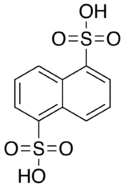| |||
| Names | |||
|---|---|---|---|
| Preferred IUPAC name
Naphthalene-1,5-disulfonic acid | |||
| Other names
Armstrong's acid
| |||
| Identifiers | |||
3D model (JSmol)
|
|||
| ChEBI | |||
| ChemSpider | |||
| ECHA InfoCard | 100.001.199 | ||
PubChem CID
|
|||
| UNII | |||
CompTox Dashboard (EPA)
|
|||
| |||
| |||
| Properties | |||
| C10H8S2O6 | |||
| Molar mass | 288.299 g/mol | ||
| Appearance | colorless solid | ||
| Hazards | |||
| Occupational safety and health (OHS/OSH): | |||
Main hazards
|
corrosive | ||
Except where otherwise noted, data are given for materials in their standard state (at 25 °C [77 °F], 100 kPa).
| |||
Armstrong's acid (naphthalene-1,5-disulfonic acid) is a fluorescent organic compound with the formula C10H6(SO3H)2. It is one of several isomers of naphthalenedisulfonic acid. It a colorless solid, typically obtained as the tetrahydrate.[1] Like other sulfonic acids, it is a strong acid. It is named for British chemist Henry Edward Armstrong.[2]
- ^ Cite error: The named reference
Ullmannwas invoked but never defined (see the help page). - ^ Senning, Alexander (2007). Elsevier's dictionary of chemoetymology. Elsevier. p. 30. ISBN 978-0-444-52239-9.

